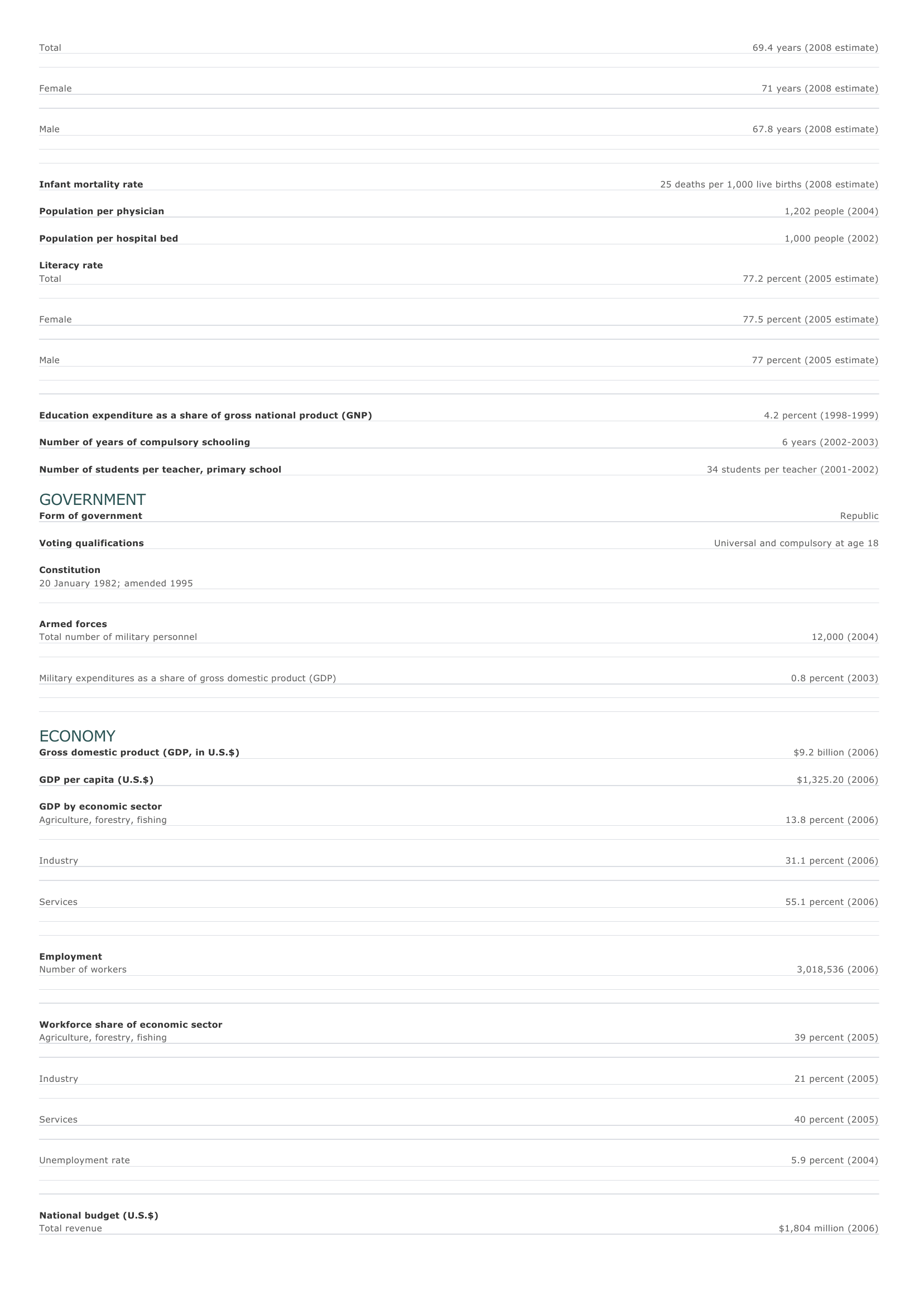
Honduras Facts and Figures. BASIC FACTS Official name Capital Area Republic of Honduras Tegucigalpa 112,492 sq km 43,433 sq mi PEOPLE Population 7,639,327 (2008 estimate) Population growth Population growth rate 2.02 percent (2008 estimate) Projected population in 2025 10,004,876 (2025 estimate) Projected population in 2050 12,641,869 (2050 estimate) Population density 68 persons per sq km (2008 estimate) 177 persons per sq mi (2008 estimate) Urban/rural distribution Share urban 46 percent (2005 estimate) Share rural 54 percent (2005 estimate) Largest cities, with population Tegucigalpa 1,324,000 (2006 estimate) San Pedro Sula 549,498 (2006) El Progreso 147,369 (2001) La Ceiba 127,590 (2001) Choluteca 120,791 (2001) Ethnic groups Mestizo 90 percent Native American (primarily Miskito, Payas, Xicaques, Zambo) 7 percent Black African 2 percent White 1 percent Languages Spanish (official), Native American dialects, Creole, English Religious affiliations Roman Catholic 86 percent Protestant 6 percent O ther 8 percent HEALTH AND EDUCATION Life expectancy Total Female Male Infant mortality rate 69.4 years (2008 estimate) 71 years (2008 estimate) 67.8 years (2008 estimate) 25 deaths per 1,000 live births (2008 estimate) Population per physician 1,202 people (2004) Population per hospital bed 1,000 people (2002) Literacy rate Total 77.2 percent (2005 estimate) Female 77.5 percent (2005 estimate) Male Education expenditure as a share of gross national product (GNP) Number of years of compulsory schooling Number of students per teacher, primary school 77 percent (2005 estimate) 4.2 percent (1998-1999) 6 years (2002-2003) 34 students per teacher (2001-2002) GOVERNMENT Form of government Republic Voting qualifications Universal and compulsory at age 18 Constitution 20 January 1982; amended 1995 Armed forces Total number of military personnel Military expenditures as a share of gross domestic product (GDP) 12,000 (2004) 0.8 percent (2003) ECONOMY Gross domestic product (GDP, in U.S.$) GDP per capita (U.S.$) $9.2 billion (2006) $1,325.20 (2006) GDP by economic sector Agriculture, forestry, fishing 13.8 percent (2006) I ndustry 31.1 percent (2006) Services 55.1 percent (2006) Employment Number of workers 3,018,536 (2006) Workforce share of economic sector Agriculture, forestry, fishing 39 percent (2005) I ndustry 21 percent (2005) Services 40 percent (2005) Unemployment rate 5.9 percent (2004) National budget (U.S.$) Total revenue $1,804 million (2006) Total expenditure $1,939 million (2006) Monetary unit 1 lempira (L), consisting of 100 centavos Major trade partners for exports United States, El Salvador, Guatemala, Canada, and Germany Major trade partners for imports United States, El Salvador, Mexico, Netherlands Antilles, and South Korea ENERGY, COMMUNICATIONS, AND TRANSPORTATION Electricity production Electricity from thermal sources 60.35 percent (2003 estimate) Electricity from hydroelectric sources 39.65 percent (2003 estimate) Electricity from nuclear sources 0 percent (2003 estimate) Electricity from geothermal, solar, and wind sources 0 percent (2003 estimate) Number of radios per 1,000 people 410 (1997) Number of telephones per 1,000 people 69 (2005) Number of televisions per 1,000 people 101 (2000 estimate) Number of Internet hosts per 10,000 people 2.8 (2003) Daily newspaper circulation per 1,000 people 55 (1996) Number of motor vehicles per 1,000 people 61 (1999) Paved road as a share of total roads 20 percent (1999) SOURCES Basic Facts and People sections Area data are from the statistical bureaus of individual countries. Population, population growth rate, and population projections are from the United States Census Bureau, International Programs Center, International Data Base (IDB) (www.census.gov). Urban and rural population data are from the Food and Agriculture Organization (FAO) of the United Nations (UN), FAOSTAT database (www.fao.org). Largest cities population data and political divisions data are from the statistical bureaus of individual countries. Ethnic divisions and religion data are largely from the latest Central Intelligence Agency (CIA) World Factbook and from various country censuses and reports. Language data are largely from the Ethnologue, Languages of the World, Summer Institute of Linguistics International (www.sil.org). Health and Education section Life expectancy and infant mortality data are from the United States Census Bureau, International Programs Center, International database (IDB) (www.census.gov). Population per physician and population per hospital bed data are from the World Health Organization (WHO) (www.who.int). Education data are from the United Nations Educational, Scientific and Cultural Organization (UNESCO) database (www.unesco.org). Government section Government, independence, legislature, constitution, highest court, and voting qualifications data are largely from various government Web sites, the latest Europa World Yearbook, and the latest Central Intelligence Agency (CIA) World Factbook. The armed forces data is from Military Balance. Economy section Gross domestic product (GDP), GDP per capita, GDP by economic sectors, employment, and national budget data are from the World Bank database (www.worldbank.org). Monetary unit, agriculture, mining, manufacturing, exports, imports, and major trade partner information is from the statistical bureaus of individual countries, latest Europa World Yearbook, and various United Nations and International Monetary Fund (IMF) publications. Energy, Communication, and Transportation section Electricity information is from the Energy Information Administration (EIA) database (www.eia.doe.gov). Radio, telephone, television, and newspaper information is from the United Nations Educational, Scientific and Cultural Organization (UNESCO) database (www.unesco.org). Internet hosts, motor vehicles, and road data are from the World Bank database (www.worldbank.org). Note Figures may not total 100 percent due to rounding. Microsoft ® Encarta ® 2009. © 1993-2008 Microsoft Corporation. All rights reserved.














